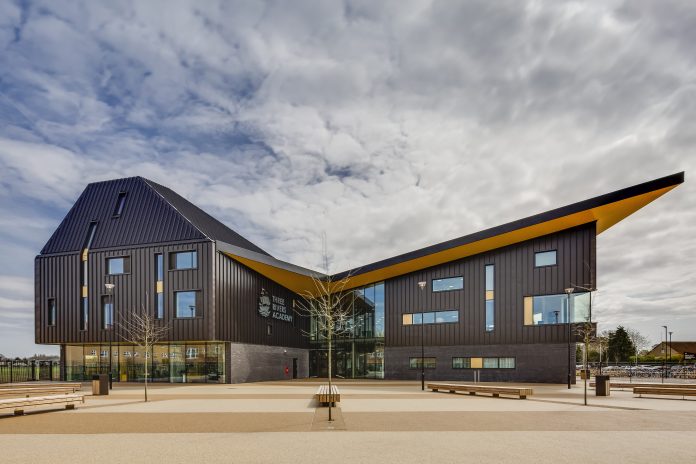The dynamic and fast-moving pace of the structural timber sector delivers a vast array of buildings through innovative construction methods. Here, Andrew Carpenter, chief executive of the Structural Timber Association, discusses the benefits of Structural Insulated Panel Systems (SIPS)
At a time when sustainable development is a global priority and at the forefront of the UK construction agenda, with key issues such as climate change dominating our future thinking, timber is an outstanding renewable material that offers a range of environmental benefits.
Structural Insulated Panel Systems (SIPS)
Developers, architects and engineers are beginning to recognise the impact of building details and specification on in-use energy performance and are keen to promote best practice. Structural Insulated Panels offer significant advantages in a world where schedules are becoming shorter, building performance criteria is becoming more challenging, and the need for innovative solutions to meet ambitious construction targets is increasing.
Structural Insulated Panel Systems are considered an advanced construction method. They deliver excellent loadbearing capability combined with structural and thermal characteristics in one system. SIP Systems can help to provide very low air permeability and help reduce levels of thermal bridging.
SIPS have two parallel faces, usually Oriented Strand Board (OSB), that sandwich a rigid core of foam insulation. The result is a lightweight system which is quick to erect and free from compression shrinkage and thermal bridging.
Structural Insulated Panel Systems are used for walls and roofs. If the house design facilitates habitable living space in the roof zone then SIPS are a fantastic solution to ensuring maximum space availability while providing superb performance.
Structural Insulated Panel Systems offer extremely high thermal performance throughout the lifecycle of the building while minimising wall thickness. The rigid insulation and OSB3 facing panels achieve U-values as low as 0.10 W/m2K, making significant savings on operating costs. Often it is possible to lower the specification of heating systems and reduce the cost and complexity of the HVAC installation. By adopting fabric first principles, high-performance building envelopes are achieved reducing ongoing maintenance and energy costs across the lifetime of the building.
There are two fundamental applications for Structural Insulated Panel Systems, a full structural building envelope or infill walling. In all cases, the product will be engineered for loadbearing capability, racking resistance and wind loading requirements.

Infill walling
Often SIP Systems are specified as infill to steel, concrete or engineered timber structural frames. They can sit on either the inside or outside of the frame itself. Infill walling is very quick to install, making it an innovative solution for all applications.
Full structural building envelope
SIP Systems can be used to form a loadbearing full structural building envelope. When compared with traditional methods of construction, the speed of build and accuracy that offsite manufactured Structural Insulated Panel construction delivers is an attractive building proposition to any developer where programme and cost certainty can effectively achieve a rapid return on investment.
Sustainable solution
Energy efficient buildings are achieved through good building fabric design. Optimising the performance of the building envelope reduces ongoing running costs, improving energy efficiency and reducing carbon emissions. Up to Passivhaus standards can be achieved if the brief demands.
Traditional construction methods and materials account for 14-16% of world carbon emissions and while site-based approaches are sometimes appropriate for certain design solutions, there must be a fundamental change in the way buildings are constructed.
It is important to raise awareness of how carbon sequestration and structural timber technology can contribute to reducing carbon emissions and help to tackle the current climate emergency.
Sequestered carbon is carbon safely trapped within timber building materials that would otherwise be in the form of atmospheric CO2. Buildings made from SIPS become an effective form of carbon storage. The innovative use of sustainable Structural Insulated Panel Systems can help to deliver high quality, high-density housing without compromising the environment.
The structural timber industry is geared for capacity and has the skills and materials to rapidly respond to create quality buildings at a rapid rate. The offsite manufacture of SIP Systems for onsite installation reduces the requirement for site labour and transportation costs are also reduced as SIP Systems are delivered in time for construction and waste material is recycled, so nothing is transported to landfill.
The accelerated building programmes delivered by Structural Insulated Panels reduce site prelim expenditure and provide a faster return on capital outlay.
Structural Timber Association (STA)
Representing over 700 members across the structural timber industry and associated supply chain, the STA has an objective to enhance quality and drive product innovation through technical guidance and research.
The association’s independently assessed membership and quality standards scheme – STA Assure, is recognised by the NHBC and six leading warranty and building control bodies. This scheme ensures all manufacturing members meet or even exceed current legislation and regulatory requirements.
There is a wealth of information available to construction professionals on the Structural Timber Association’s website, from advice on structural timber systems to market reports and ‘find a member’ search system. For more information visit: www.structuraltimber.co.uk
Andrew Carpenter
Chief executive
+44 (0)1259 272140














